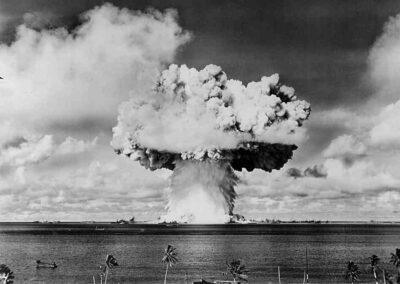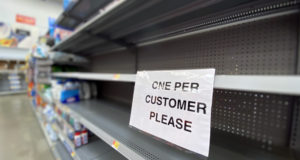
image credit npr.org
The U.S. government has been keeping information secret that proves nuclear weapons have been a far greater danger to average Americans than we believed. A recently declassified document shows that the US Air Force once dropped two live hydrogen bombs (the most powerful nuclear weapons) on North Carolina – and one nearly exploded.
The bombs fell on Goldsboro, North Carolina, when a B-52 bomber crashed on Jan. 23, 1961, author Eric Schlosser told The Guardian. Each of the Mark 39 bombs had the explosive power of four million tons of TNT – 260 times more powerful than the Hiroshima bomb.
Inadequate Safety Mechanisms
Schlosser believes that one of the weapons nearly went off during the incident, and he claims the bomb would have deposited lethal fallout all over the East Coast if it went off. A 1969 report about the incident written by a nuclear weapons expert named Parker F. Jones found that the bombs dropped on North Carolina contained inadequate safeguards.
In fact, three out of four safety mechanisms in one of the bombs didn’t work, Jones concluded. When the bomb landed near Faro, N.C., it nearly exploded.
“Its parachute opened, its trigger mechanisms engaged, and only one low-voltage switch prevented untold carnage,” The Guardian said.
If that switch had shorted by a jolt of electricity, the bomb would have detonated.
How To Survive A Dirty Bomb Blast, An Atomic Explosion, Or Even A Nuclear Reactor Meltdown
The truly frightening thing is that the Goldsboro incident is only the worst of numerous U.S. weapons mishaps that Schlosser discovered in classified documents. The author believes that nuclear weapons are a far greater danger than we were led to believe.
“The U.S. government has constantly tried to withhold information from the American people in order to prevent questions being asked about our nuclear weapons policy,” Schlosser said. “We were told there was no possibility of these weapons accidentally detonating, yet here’s one that very nearly did.”
Other Nuclear Weapons Mishaps
In research for a book on nuclear weapons, Schlosser made some frightening and very disturbing discoveries in declassified documents. Some of the highlights include:
- There were at least 700 significant accidents involving 1,250 nuclear weapons in the United States between 1950 and 1968.
- The possibility of a nuclear weapon detonating accidently was far greater than officials claimed.
- The US government deliberately deceived the American people by covering up the potential danger.
- A Titan II missile exploded in a silo in Arkansas in 1980. At the time of the explosion the missile was carrying a nuclear bomb 600 times more powerful than the one dropped on Hiroshima. The warhead did not detonate.
- In 1958 another nuclear bomb was dropped accidentally into the backyard of a family in Mars Bluff, South Carolina.
- The US Air Force actually lost a hydrogen bomb in 1966. The bomb fell into the ocean off of Spain from a B-52 and wasn’t found for six weeks.
- At one point it was possible to fool security systems at some nuclear missile bases with a credit card.
- The United States still has an arsenal of around 4,650 nuclear weapons.
- There are around 9,100 nuclear weapons in the world today (4,650 in the USA, 3,500 in Russia, 400 in China, 400 in France and 150 in the UK). These numbers don’t cover other nuclear powers such as Israel, India, North Korea and Pakistan.
- A report on nuclear weapons mishaps that occurred in the U.S. between 1957 and 1967 was 245 pages long.
Schlosser spent 14 years working on his book Command and Control: Nuclear Weapons, the Damascus Accident and the Illusion of Safety. During that time he read hundreds of declassified documents and interviewed more than 100 people including bomber pilots, scientists and weapons designers. Schlosser found that many of those people are staunchly opposed to nuclear weapons because of their experiences.
“This is the scary thing for me,” Schlosser said. “The people for whom this still a threat, the people who are the most anti-nuclear, the people who are most afraid about this, are the ones who know most about it.”
 Off The Grid News Better Ideas For Off The Grid Living
Off The Grid News Better Ideas For Off The Grid Living



